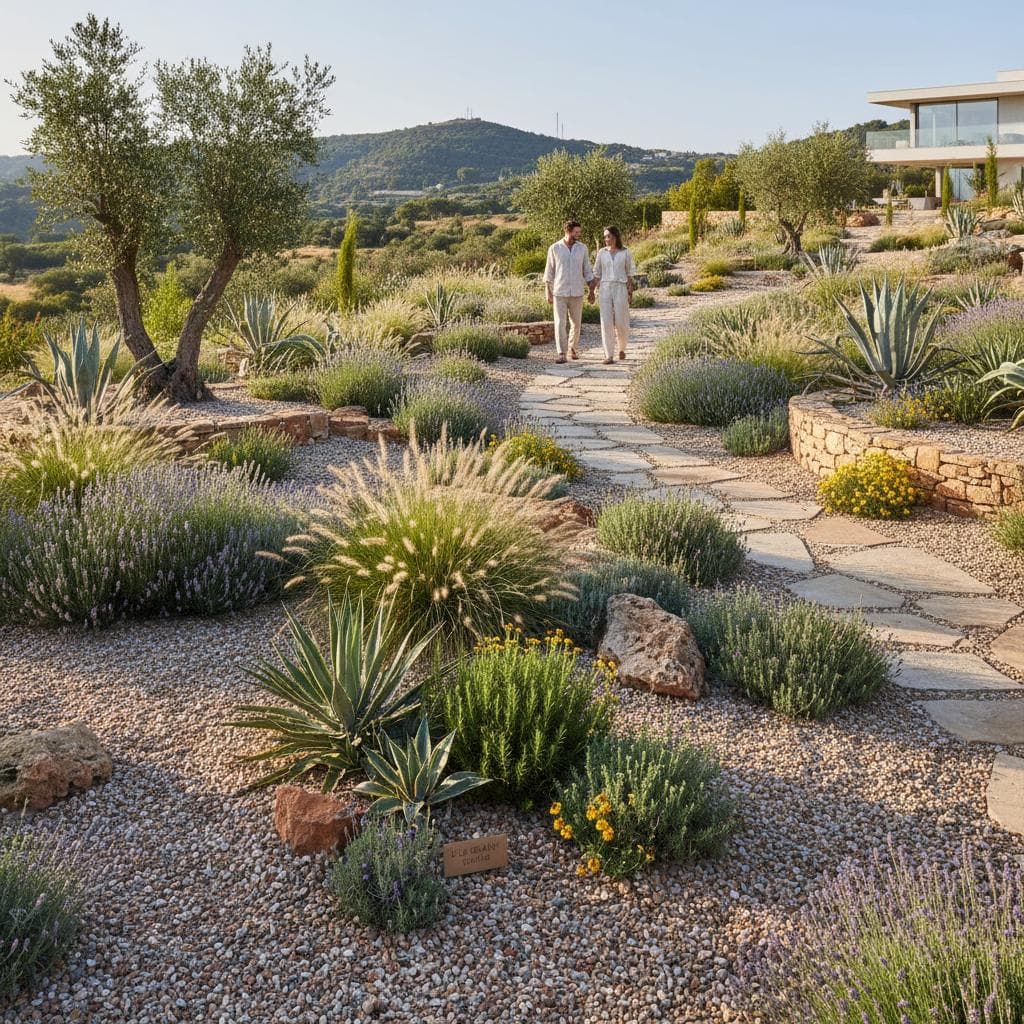Building Resilient Gravel Gardens for Dry Climates
Homeowners Mia and Rafael faced a challenge on their hillside property: creating a landscape that endured extended dry periods without frequent watering. They sought a garden that maintained vitality throughout the seasons, offering evolving textures and colors. The outcome, a gravel garden celebrated online for its effortless appeal and bold aesthetics, fulfills these needs while emphasizing sustainability.
Crafting the Entry Path
As visitors approach, the crunch of gravel signals entry into a thoughtfully composed space. The pathway consists of compacted decomposed granite that winds among groupings of water-wise plants. Landscape designer Lila Grant selected a mix that balances untamed energy with intentional structure. She notes, "The aim was to craft a garden that appears self-reliant, yet each element serves a deliberate role."
Borders along the path include the silvery foliage of Artemisia powis castle, the blue-green tufts of Festuca glauca, and creeping mounds of Thymus serpyllum that release fragrance underfoot. These selections temper the gravel's starkness, adding depth to the walkway without any need for supplemental irrigation. To install a similar path, start by excavating six inches deep, compact the base, and layer plants at intervals of 12 to 18 inches for natural coverage.
Developing the Central Terrace
The garden's heart features a circular terrace constructed from varied limestone slabs. Pale gravel fills the joints, ensuring water permeability and a seamless integration with the surroundings. This versatile area supports a fire pit for gatherings and serves as an al fresco dining venue. Mia and Rafael desired a spot that connected deeply with the natural terrain rather than standing apart.
Surrounding the terrace, steel planters hold Euphorbia characias with its upright form, Agave parryi for architectural drama, and Lavandula angustifolia that echoes the gravel's muted palette. These plants excel in fast-draining conditions and retain their silhouette during arid times. Rafael explains, "We sought definition without stiffness; these choices provide form that persists through drought."
For replication, position planters at 24-inch spacings around the terrace edge. Select steel for its rust resistance, and fill with a gravel-soil blend at a 70-30 ratio to promote root health.
Selecting Plants for Dynamic Textures
Success in gravel gardens hinges on visual and tactile contrasts. Grant paired the spiky profiles of agaves with the fluid sway of grasses to generate interest. Key plantings in the beds encompass Stipa tenuissima for its fine, whispering fronds, Salvia nemorosa ‘Caradonna’ offering deep purple spikes in summer, and Sedum ‘Autumn Joy’ that shifts from green to rusty hues in fall. These varieties tolerate intense sun and lean soils while providing reliable blooms and structure.
Gravel application varies for enhanced effect: three-eighths-inch pieces suit finer textures in upper areas, while one-inch stones anchor lower slopes for better drainage. Grant observes, "Texture animates a gravel garden; it captures light differently on each material, creating movement."
To achieve this, prepare beds by tilling in organic matter sparingly, then top with two inches of gravel. Space plants according to mature size—grasses at 24 inches apart, succulents closer at 12 inches—to allow for gradual filling without overcrowding.
Implementing Efficient Water Management
Beneath the gravel surface, a drip irrigation system delivers water precisely to plant roots, minimizing waste and evaporation. This concealed setup activates only as needed, often just once weekly during peak dry spells. Gravel mulch further aids by moderating soil temperatures and blocking weed growth.
Mia manages upkeep personally. She states, "I dedicate about an hour monthly to removing volunteer seedlings and deadheading flowers." By substituting former turf with native groundcovers like Erigeron karvinskianus, the couple halved their water consumption. Their garden flourishes amid drought, contrasting with wilting nearby lawns.
Install the system by burying lines 6 to 8 inches deep in trenches before adding gravel. Use timers linked to soil moisture sensors for automation, ensuring targeted delivery of one gallon per plant per session.
Choosing Durable Materials
Selections prioritize longevity and environmental harmony. Locally sourced limestone gravel withstands weathering, bounces back sunlight to cool the surface, and blends with the site's geology. Steel edging, buried two inches deep, contains gravel spills and maintains clean lines along paths and beds.
Terrace furnishings feature powder-coated aluminum tables and chairs, which resist corrosion from coastal exposure and allow easy repositioning. For illumination, low-voltage LED lights tuck among grass clumps, projecting soft glows that mimic natural twilight across the stones.
Source materials within 50 miles to reduce transport emissions. Test gravel for pH neutrality (around 7.0) to suit most drought-tolerant plants, and apply edging with stakes every three feet for stability.
Integrating the Garden into Daily Life
Since its installation, the gravel garden continues to attract digital admiration for its poised elegance and practicality. The blend of purposeful shapes, utility, and subtlety illustrates drought-adapted design's potential without austerity. Mia and Rafael report a shift in their outdoor routines: sharing meals by the fire pit, observing bees on the lavender blooms, and enjoying freedom from irrigation demands.
For those embarking on a gravel garden, Grant advises incremental steps. Begin with a modest area, such as a 10-by-10-foot entry zone, to test plant compatibility and gravel feel. Focus on natives suited to your zone—consult local extension services for lists—and align stone tones with home exteriors for cohesion.
Steps to Launch Your Gravel Garden
- Assess your site: Evaluate slope, sun exposure, and soil type to select appropriate gravel and plants.
- Plan the layout: Sketch paths, terraces, and beds, incorporating 40 percent hardscape to 60 percent planting for balance.
- Source plants: Prioritize species with deep roots, like yarrow or penstemon, rated for your USDA hardiness zone.
- Install irrigation: Lay subsurface lines before gravel to avoid disruption later.
- Layer materials: Apply gravel in stages, starting with larger pieces at the base for erosion control.
- Maintain seasonally: Prune in spring, refresh gravel annually, and monitor for pests without chemicals.
This approach yields a landscape that not only conserves water but also enriches daily living with resilient, evolving beauty.

